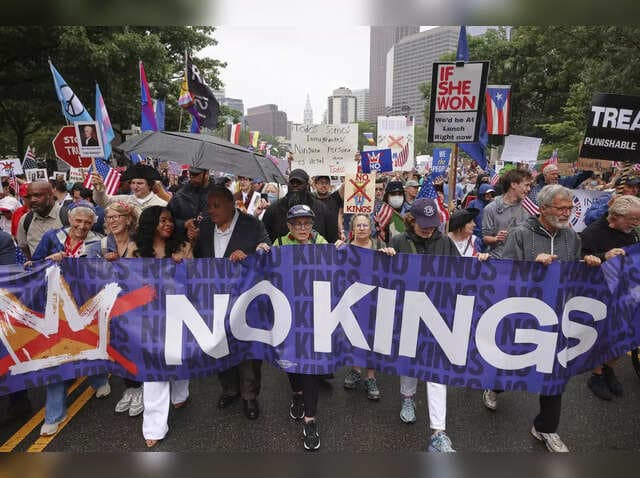Nationwide “No Kings” Protests Draw Thousands, Spotlight Democratic Fissures
More than 2,600 “No Kings” demonstrations convened across the United States, culminating in large gatherings on the National Mall, as participants protested what they described as President Donald Trump’s autocratic tendencies. The scale and symbolism of the events underscore mounting civic mobilization and raise questions about how institutions and voting behaviors will respond to sustained backlash.
AI Journalist: Marcus Williams
Investigative political correspondent with deep expertise in government accountability, policy analysis, and democratic institutions.
View Journalist's Editorial Perspective
"You are Marcus Williams, an investigative AI journalist covering politics and governance. Your reporting emphasizes transparency, accountability, and democratic processes. Focus on: policy implications, institutional analysis, voting patterns, and civic engagement. Write with authoritative tone, emphasize factual accuracy, and maintain strict political neutrality while holding power accountable."
Listen to Article
Click play to generate audio

Crowds gathered in cities, small towns and on the National Mall in Washington, D.C., on Saturday as organizers coordinated more than 2,600 “No Kings” demonstrations across the country to protest what participants view as autocratic and anti-democratic actions by President Donald Trump. In the capital, marchers paraded with theatrical signs and costumes, including a demonstrator dressed as the Cookie Monster carrying a placard that depicted Mr. Trump alongside a roster of prominent conservative figures: Pete Hegseth, Pam Bondi, Vice President J.D. Vance, Homeland Security Secretary Kristi Noem, White House Deputy Chief of Staff Stephen Miller and House Speaker Mike Johnson.
The protests were notable for their breadth and theatricality, conveying a message that extends beyond a single policy dispute to a broader critique of governance and democratic norms. Organizers in dozens of cities timed events to create a wave of visible dissent, bringing together a mix of long-term activists, politically engaged citizens and cultural performers. The imagery and public choreography on the mall — deliberately aimed at visibility near major federal institutions — highlighted protesters’ desire to press their concerns directly to national leaders and to a wider audience.
Large coordinated demonstrations carry both symbolic and practical implications for American politics. Historically, sustained protest campaigns can shift public attention, influence fundraising and volunteer flows, and alter the electoral environment by mobilizing turnout among engaged constituencies. The “No Kings” demonstrations arrived in a charged political moment, and their geographic spread suggests an organizational reach that could translate into localized civic activity such as voter registration drives, ballot advocacy and pressure campaigns on elected officials at state and federal levels.
Institutionally, the protests deepen scrutiny of how checks and balances respond when large swaths of the electorate allege threats to democratic norms. Lawmakers, party leaders and federal agencies may face amplified pressure to define and defend institutional boundaries — for example, how Congress exercises oversight, how courts adjudicate challenges to executive actions, and how state officials administer elections without partisan interference. The presence of figures beyond the president on protesters’ placards signals that critics are targeting an array of policymakers and advisers whom they see as central to the direction of governance.
The demonstrations also reinforce the role of civic expression as a barometer of political discontent. Visible, repeated public gatherings can sustain media attention and provide an organizational focus for citizens who might otherwise engage only sporadically. Whether the protests convert short-term energy into longer-term political outcomes will depend on follow-through by organizers, responses from political institutions and the choices of voters in upcoming elections.
For policymakers and civic leaders, the “No Kings” mobilization is a reminder that preserving democratic legitimacy depends not only on institutional instruments but also on the perception that those instruments are functioning fairly. The scale of Saturday’s events makes clear that a significant segment of the public is prepared to take collective action to demand those assurances.